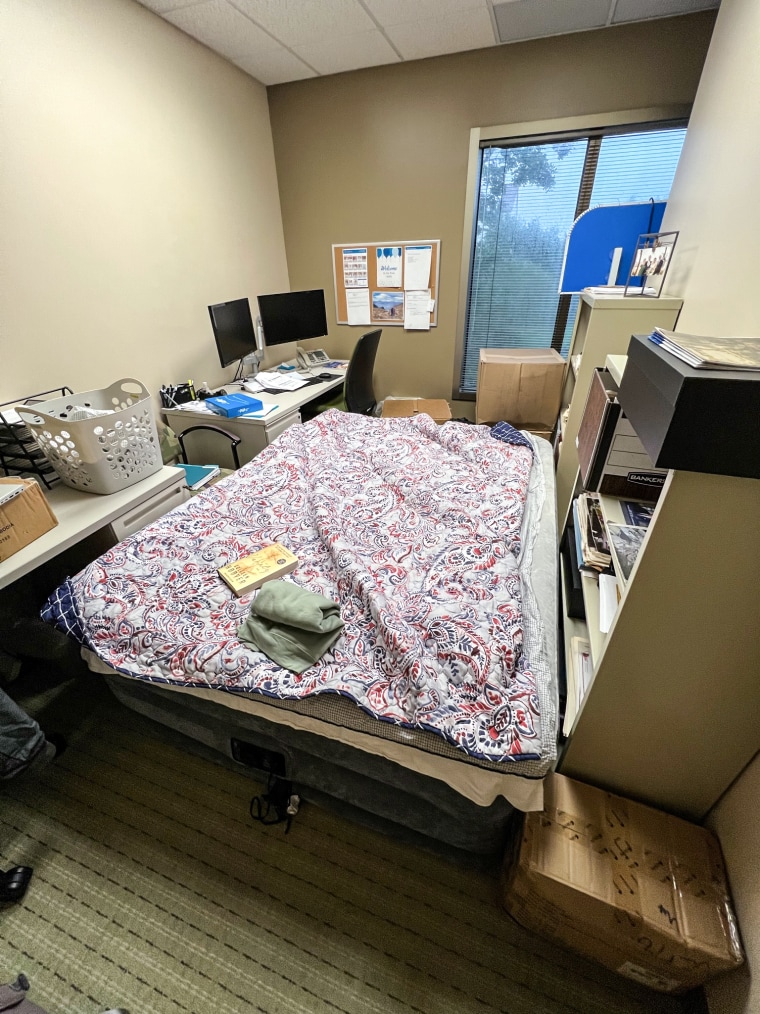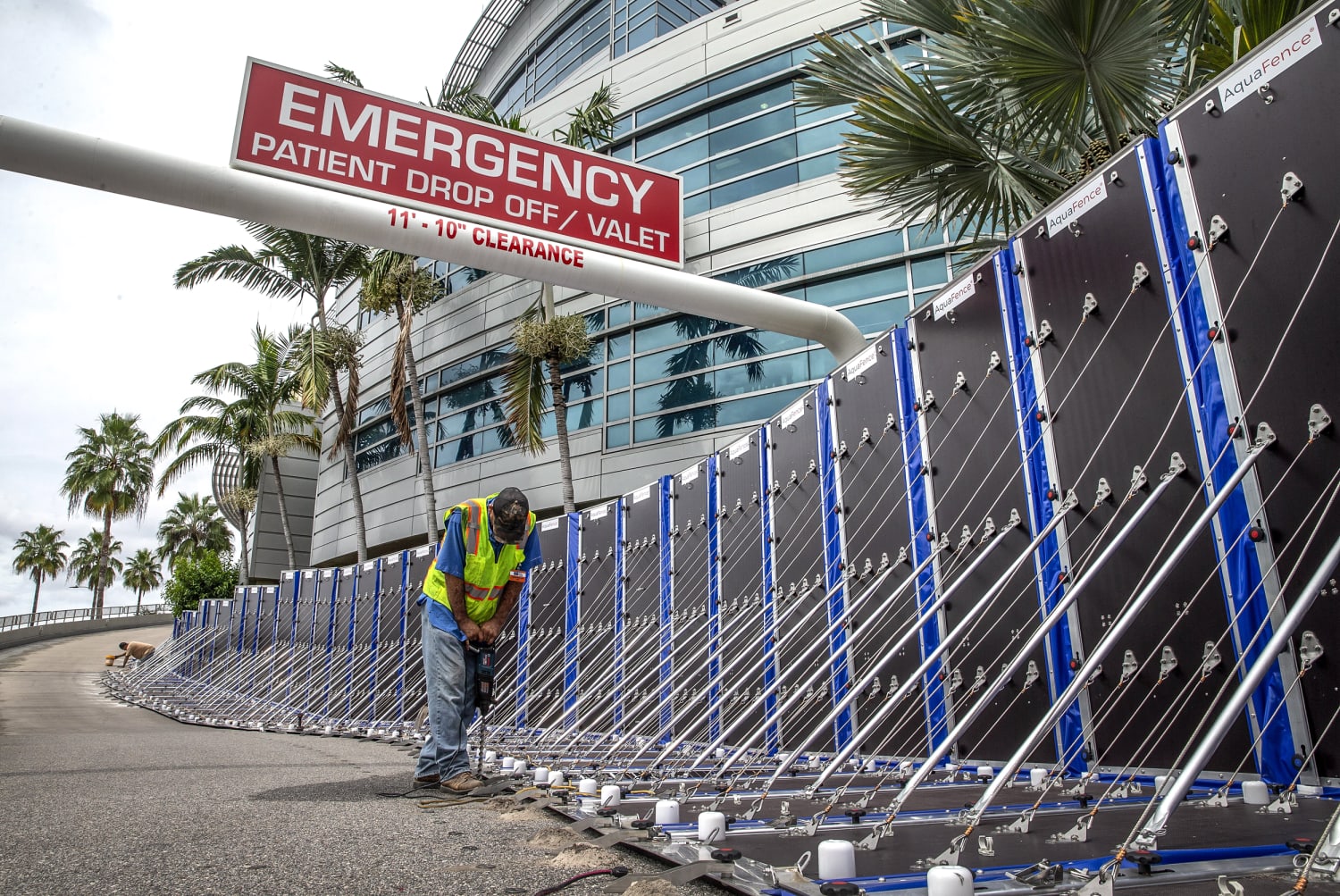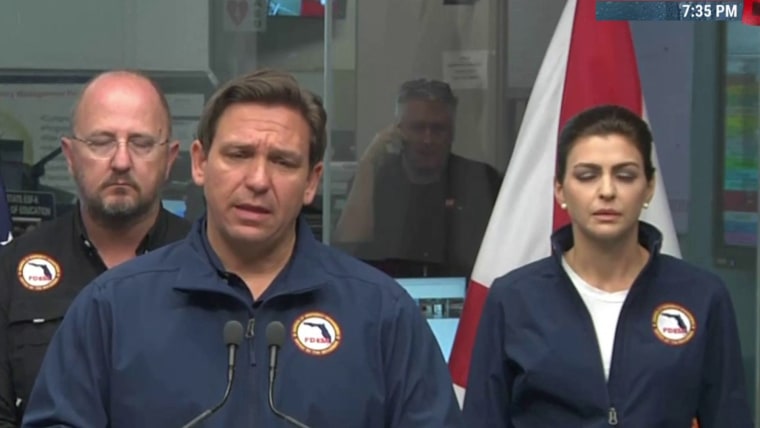Hurricane Ian has forced several Florida hospitals to evacuate patients and place staff members on lockdown as facilities contend with power outages and critical disruptions to water supplies.
Mary Mayhew, the CEO of the Florida Hospital Association, said 16 hospitals across the state had evacuated or were in the process of evacuating Thursday afternoon.
Some moved patients earlier this week when the hurricane was expected to make landfall in the Tampa Bay area, she said. Hurricane Ian ultimately made landfall near Fort Myers, about 100 miles south of Tampa Bay, on Wednesday.
Emergency responders are concerned about operations in Lee County, where are at least nine hospitals are without water, Deanne Criswell, the administrator of the Federal Emergency Management Agency, said Thursday on MSNBC’s “Morning Joe.”
Lee Health, one of the county’s largest health systems, has evacuated more 1,000 patients because of the disrupted water supply, Mayhew said.
“A hospital can’t safely care for their patients without water, and they are in the process of working closely with local and state officials to evacuate their patients because it is unclear how soon that water can be restored,” Mayhew said.
Physical damage to hospitals limited
Few hospitals have sustained major physical damage, but hurricane winds stripped part of the roof from an intensive care unit at HCA Florida Fawcett Hospital in Port Charlotte on Wednesday. Staff members moved critically ill patients to other floors and mopped up the water with towels and plastic bins.
Fawcett said in a statement that it evacuated its sickest patients before the storm made landfall. It was transferring 160 more patients to other hospitals after the roof damage caused leaks, it said.
Kindred, a hospital system providing long-term acute care, also evacuated patients from locations in Tampa and St. Petersburg on Wednesday. In total, 44 patients were moved by ambulance to a facility in central Tampa, said Susan Feeney, Kindred’s division vice president of communications. The hospital is waiting on word from the state about when the patients can be transported back, she said.
“They’re very, very sick patients,” Feeney said. “Many of them have multiple chronic conditions, and a very large percentage of our patients are ventilator-reliant.”
An Advent Health hospital in Tarpon Springs also transported patients to its sister facilities throughout the Tampa Bay area Tuesday evening. The patients are set to return to the Tarpon Springs location Friday, the hospital said in a statement.
Meanwhile, other hospitals are initiating emergency procedures. Flagler Health in St. Johns County went on “soft lockdown” Thursday morning, meaning it is closed to visitors and won’t be performing elective procedures.
Erin Wallner, a public information officer at Flagler Health, said around 350 staffers will spend the night on cots. The hospital is equipped with a 2-ton generator in case power goes out, and it has placed sandbags outside to protect against flooding, she said. All doors have been locked, aside from the emergency room entrance.

Wallner said a baby was born during the lockdown.
“We discharged prior to the storm anyone that reasonably could be discharged,” she said. “We had open heart cases that were just done prior to the storm, and they’re here and recovering safely.”
But new injuries from the hurricane could pose an additional challenge, Mayhew said.
“There were hundreds of search and rescue operations underway, so I would absolutely anticipate that our hospitals are starting to see individuals arriving from those search and rescue operations that need hospital care,” she said.
Mayhew said damage to the electrical grid could also “have a ripple effect across the health care system,” because hospitals can’t safely discharge patients to homes or nursing facilities that don’t have power.
An escalating threat to Florida hospitals
Hurricane Ian could be a preview of what Florida hospitals can expect in the coming decades.
A study released Thursday by researchers at the Harvard T.H. Chan School of Public Health assessed flooding damage to Florida hospitals through the end of the century, assuming less than 3 feet of sea level rise.
The researchers determined that a Category 2 hurricane — a storm with winds of 96 to 110 mph that can uproot trees or damage roofs — could threaten access to care in more than 60 hospitals across six Florida metropolitan areas (Miami, Orlando, Tampa, Sarasota, Jacksonville and Fort Myers).
At least 21,000 hospital beds are at risk, the report found.
The study’s senior author, Dr. Aaron Bernstein, the interim director of Harvard Chan C-CHANGE, a climate change program, said that although Florida hospitals have been well-prepared for hurricanes in the past, future storms are likely to be more dangerous.
“Fort Myers and the Tampa Bay area have invested a lot in hurricanes. They know hurricanes. People in Florida grew up with them. The problem is that climate change is making hurricanes unlike the ones that people have known,” Bernstein said.
One of the biggest challenges to hospital care during a storm is road access, he said.
Bernstein’s study projected that all roads within a mile of hospitals in Punta Gorda are at risk of flooding from a Category 2 storm through the end of the century. In Naples, around 99% of such roads are likely to be flooded. And in metro Miami, it is 72%.
Bernstein said cities tend to build hospitals “in the image of Fort Knox” to prepare for hurricanes by stockpiling supplies and erecting sea walls and submarine doors. But such safeguards aren’t as useful if roads are closed, he said: “You can build Fort Knox, but if you can’t get there, what good is it?”
Restricting access to hospitals could have lasting health effects, he added, beyond storm-related deaths.
“When you cut off health care access, any chronic medical condition may get worse, because people aren’t getting care,” he said. “Even without the care access being totally compromised, we see folks who have the least means really suffering, because they’re trying to afford repairing their home or extra expenses and they sacrifice their health.”
A 2019 study found that lung cancer patients who were exposed to a hurricane while they were receiving radiation had worse survival rates than patients who weren’t exposed. The risk of death increased the longer the disaster stretched on.
Mayhew said Hurricane Ian’s aftermath could put vulnerable people in an even more vulnerable position.
“It is going to be weeks before the damage is fully understood, and it may take months to restore the infrastructure,” she said. “That level of uncertainty is daunting when it comes to making sure that you’ve got 24/7 health care operations up and running.”
Source: | This article originally belongs to Nbcnews.com











